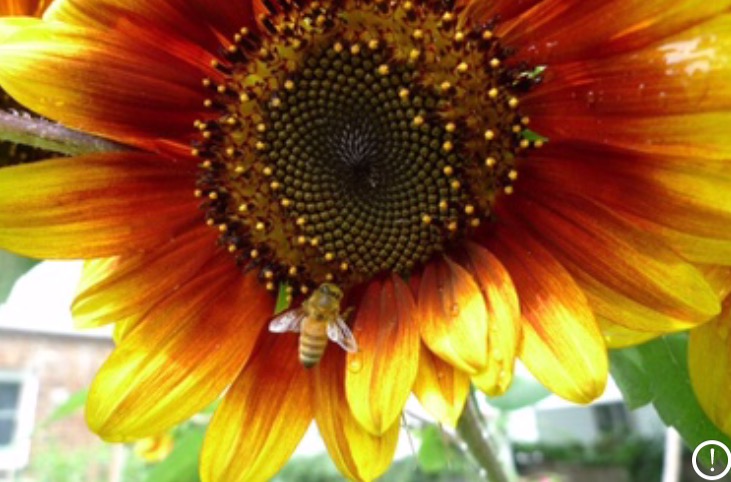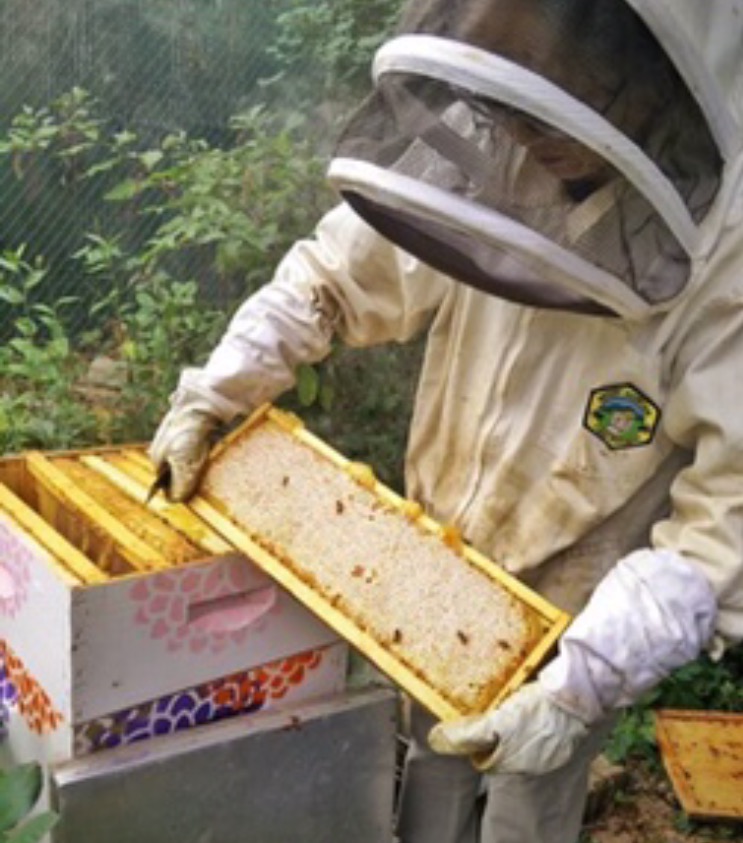Written by Ruth Harrigan – Urban Beekeeper & Gardener

As civilization continues to encroach on wild habitats it is now more imperative than ever for gardeners like us to lend a hand to all the pollinators who need a variety of flowers as a source of nectar and pollen. An oasis can be easily created for our pollinating friends such as bees, moths, beetles, birds, bats, and butterflies by planting a mix of native flowers and plants.
Reports on climate change and environmental factors that may affect the health of bees are particularly alarming to a beekeeper like me. The plight of the honeybee and Colony Collapse Disorder (CCD) are devastating honeybee colonies around the world. So far in 2017 the Bumble bee and 7 Hawaiian yellow-faced bees were put onto the endangered species list and the Monarch butterfly may follow suit.

Ruth in her bee yard.
Let’s do our part in helping the pollinators by doing what we love, gardening which allows them to do what they love, pollinating. This symbiotic relationship will have all of us come out smelling like roses.
Here is list of plants favored by specific pollinators. Of course, you will have native plants in your region of the country that are best for the area’s climate and pollinators. A great source for pollinator plants local to you are the pollinator planting guides from www.pollinator.org. They have 32 guides for specific regions of the U.S. and four for Canada to help you plant a local pollinator garden. Here is an overview of some of the most popular flowers, trees, bushes, fruits, and vegetables to plant to attract pollinators.
Best Plants to Attract Butterflies, Hummingbirds, and Bees
Butterflies: Butterflies not only pollinate as they flutter around the garden sipping nectar from flowers they also lay their eggs on the leaves of host plants. To protect from predators the female butterfly will lay her eggs on the underside of the leaves of a host plant. Monarch and The Queen butterfly favor the milkweed plant. Pipevine Swallowtails are partial to the pipevine, snakeroot, and knot vine. Black Swallowtail butterflies like parsley, carrots, and parsnips as their host plants for their eggs. Once the caterpillar is born it will eat the leaves of the host plant.
- Milkweed – is the number one plant for attracting Monarch butterflies. Look for genus Asclepias at your local nursery. You can also get 15 free Milkweed seeds from https://www.livemonarch.com/free-milkweed-seeds.htm
- Alyssum
- Aster
- Bee balm
- Butterfly Bush – the name says it all!
- Calendula
- Cosmos
- Delphinium
- Parsley
- Pipevine
Hummingbirds: Hummingbirds like long tubular bright flowers and lots of nectar. Additionally, you could add a hummingbird feeder to your garden for extra enticement.
- Azalea
- Beard Tongue
- Coral Honeysuckle
- Daylily
- Flowering Quince
- Foxglove
- Jewelweed
- Lupine
- Petunia
- Trumpet Creeper
Bees: Bees are attracted to the colors blue, purple, and yellow. Flowers of these colors will be most enticing to bees. Also, bees like flat or shallow blossoms making it easier for them to reach the inner part of the flower. And let’s not forget our fruits and vegetable gardens as they attract bees as well.
- Alyssum
- Anise Hyssop
- Aster
- Bee Balm
- Black-eyed Susan
- Clover
- Daisy
- Echinacea
- Poppy
- Zinnia
Bee Friendly Fruits & Vegetables:
- Apple
- Blueberry
- Cucumber
- Kale
- Peach
- Pear
- Raspberry
- Strawberry
- Squash, pumpkin, gourds
- Tomato
More things we can do to help the pollinators:
- Stop using pesticides and go organic. Using pesticides in your garden while trying to provide a safe haven for pollinators is counter productive. Try your best to use natural solutions to pest control.
- Become a backyard beekeeper – there’s nothing better than fresh raw honey. It only takes one beehive to have a great source of pure honey and wax for making your own tea lights. It has never been easier to learn how to keep bees, there are many local beekeeping clubs around the country and almost every county has one. We even learned how to keep bees in New York City!
- Provide shelter – bat boxes, mason bee habitats, bird houses are great ways to provide shelter for pollinators. Even thick bushes and a pile of wood make ideal shelters.
- Provide food & water – pollinators are seeking nectar and pollen but they work hard all day and would benefit from a fresh water source and food. Monarch butterflies especially like muddy puddles for salt and minerals as well as the water.
- Do not eat GMO Corn & Soy – GMO corn and soy are the main reason for the staggering decline in Monarch butterflies. GMO corn and soy have been modified to withstand the herbicide glyphosate or more commonly known as Round Up. The problem is glyphosate is not a selective weed killer and kills all weeds it comes into contact with. As glyphosate usage has exploded across the country milkweed habitats have declined 60% and in turn the Monarch population has declined 80%.
- Support companies helping the pollinators survive – hundreds of companies around the country (and the world) are seeing the need to help and get the word out about the threat to our pollinator species. Companies like General Mills makers of Honey Nut Cheerios just gave away over 1 billion seeds to be planted to provide much needed flowers for the honeybees. Companies like Seedles make fun throwable seed “bombs” you can use to plant pollinator friendly flowers anywhere. Just toss them into a vacant lot or by the train tracks and let wildflowers grow!
Remember, a garden is truly not possible without pollinators. They are an integral part of our ecosystem whether it be in the mountain meadows of Colorado, the grassy plains of Nebraska, on a city terrace with potted plants, or in your backyard. Let’s all do our part in helping all the pollinators thrive.
Ruth Harrigan is a NYC beekeeper & Gardener who makes sure to have plenty of local native plants in her backyard garden for her pollinator friends. Try Ruth’s Gardeners’ Choice Hand Cream available at www.MeeBeauty.com all subscribers to Mike’s Gardening Newsletter can use code MBN15 for 15% off. Mee Beauty donates to 1% FOR THE PLANET to help pollinators!
Sources:
http://www.buzzaboutbees.net/bee-friendly-plants.html
http://www.gardeners.com/link-page?cid=5024
http://www.gardeners.com/how-to/attracting-butterflies-hummingbirds/7265.html
http://www.hummingbirds.net/attract.html
http://www.ourhabitatgarden.org/creatures/milkweed-growing.html
http://www.enchantedlearning.com/subjects/butterfly/allabout/Garden.shtml
http://www.livescience.com/43678-milkweed-and-monarchs-disappearing.html
Resources:
http://www.pollinator.org
https://www.livemonarch.com/free-milkweed-seeds.htm
Ruth and all,
Its great you are promoting beekeeping and planting bee frendly plants but…..
You must know beekeeping is much mor complex and time consuming than most know.
You just can’t buy a package of bees from tractor supply, buy some hive bodies throw the bees in there and walk a away.
I would suggest you contact a local beekeepers club in your area and learn proper beekeping techniques. That way your investment of several hundred dollars won’t go down the drain. Plus the fact that your varroa mite infected hives are not spreading those nasty buggers to other beekeepers hives.
I did not know the butterfly bush was invasive so I went searching for more info. I found this great article that summarizes the problem and then gives alternatives. If this helps others, then good. Obviously this is a hot topic so I am not adding this to be in the argument., just wanted to share what I found to be helpful information
http://www.thoughtco.com/why-you-shouldnt-plant-butterfly-bush-1968210
You want butterfly weed, not butterfly bush. Butterflies will go to Buddleia for nectar, but it is not a host plant. It is invasive. Butterfly weed is asclepias, or milkweed.
Don’t forget about the Mushrooms!!! It has been recently discovered that the understanding of the great decline of pollinators is actually due to the lack of mycelium in their diet due to alot of pollen plants being in areas without areas of old growth forest.
It is becoming more popular for people to make mushroom gardens on mulch which makes very interesting features in areas of your garden that may be dark and hard to grow other things.
Mycelium is just as essential for the bees and pollinators as the plants are.
Jay, I’ve never read anything about this. Where can I find more info on this?
Annie,
I am a beekeeper and i went to a beekeper’s confrence last summer and there’s some very interesting research going on the mycellium and honey bee connection. If you want more info you can contact me at my blog at http://beanstockfarm.blogspot.com
Thank you-great article!
When you choose to become a beekeeper ensure you are not allergic to bee stings. Bee sting allergy is something you can develop at any time. Nothing to be scared off, but vigilance is absolutely necessary.
One year I planted buck wheat as a cover. When it matured and produced white flowers, bumble bees were all over it. Evidently they like it.
Swallowtails here in California also lay eggs on Fennel (Dill Weed) The larvae eat the strong smelling plant and taste terrible to the birds. Monarchs so something similar, Asclepsias is mildly toxic, and the birds get sick if they eat Monarch larvae.
California Monarchs are picky. They like the wild pale pink/white flowered Asclepsias. I have the bright orange kind from the nursery, but they ignore it. They sometimes lay eggs on parsley plants. The flat leaf Italian kind seems most popular.
We have Buddlea in our freeway landscape! Yea-a-a Calif. Highway Dept!
Thank you very good info I got my seed from cheerios gonna plant them soon